Whispering-Gallery-Mode for Coherent Random Lasing in a Dye-Doped Polystyrene Encapsulated Silica-Glass Capillary
Abstract
1. Introduction
2. Materials and Methods
2.1. DPP Synthesis and Random Lasing Measurements
2.2. The Preparation of Dye-Doped Polystyrene (DDPS)
2.3. The Preparation of Dye-Doped Mixed Solution (DDMS)
3. Results
4. Conclusions
Author Contributions
Funding
Conflicts of Interest
References
- Reynolds, T.; Riesen, N.; Meldrum, A.; Fan, X.D.; Hall, J.M.M.; Monro, T.M.; Francois, A. Fluorescent and lasing whispering gallery mode microresonators for sensing applications. Laser Photonics Rev. 2017, 11, 1600265. [Google Scholar] [CrossRef]
- Foreman, M.R.; Swaim, J.D.; Vollmer, F. Whispering gallery mode sensors. Adv. Opt. Photonics 2015, 7, 168–240. [Google Scholar] [CrossRef] [PubMed]
- Rosenblum, S.; Lovsky, Y.; Arazi, L.; Vollmer, F.; Dayan, B. Cavity ring-up spectroscopy for ultrafast sensing with optical microresonators. Nat. Commun. 2015, 6, 6788. [Google Scholar] [CrossRef] [PubMed]
- Dong, C.H.; He, L.; Xiao, Y.F.; Gaddam, V.R.; Ozdemir, S.K.; Han, Z.F.; Guo, G.C.; Yang, L. Fabrication of high-Q polydimethylsiloxane optical microspheres for thermal sensing. Appl. Phys. Lett. 2009, 94. [Google Scholar] [CrossRef]
- Li, B.-B.; Wang, Q.-Y.; Xiao, Y.-F.; Jiang, X.-F.; Li, Y.; Xiao, L.; Gong, Q. On chip, high-sensitivity thermal sensor based on high-Q polydimethylsiloxane-coated microresonator. Appl. Phys. Lett. 2010, 96. [Google Scholar] [CrossRef]
- Strekalov, D.V.; Thompson, R.J.; Baumgartel, L.M.; Grudinin, I.S.; Yu, N. Temperature measurement and stabilization in a birefringent whispering gallery mode resonator. Opt. Express 2011, 19, 14495–14501. [Google Scholar] [CrossRef]
- Nam, S.H.; Yin, S.H. High-temperature sensing using whispering gallery mode resonance in bent optical fibers. IEEE Photonic Technol. Lett. 2005, 17, 2391–2393. [Google Scholar]
- Martin, L.L.; Perez-Rodriguez, C.; Haro-Gonzalez, P.; Martin, I.R. Whispering gallery modes in a glass microsphere as a function of temperature. Opt. Express 2011, 19, 25792–25798. [Google Scholar] [CrossRef]
- Weng, W.L.; Anstie, J.D.; Stace, T.M.; Campbell, G.; Baynes, F.N.; Luiten, A.N. Nano-Kelvin Thermometry and Temperature Control: Beyond the Thermal Noise Limit. Phys. Rev. Lett. 2014, 112, 160801. [Google Scholar] [CrossRef]
- Bashar, S.B.; Wu, C.X.; Suja, M.; Tian, H.; Shi, W.H.; Liu, J.L. Electrically Pumped Whispering Gallery Mode Lasing from Au/ZnO Microwire Schottky Junction. Adv. Opt. Mater. 2016, 4, 2063–2067. [Google Scholar] [CrossRef]
- Wu, Y.; Leung, P.T. Lasing threshold for whispering-gallery-mode microsphere lasers. Phys. Rev. A 1999, 60, 630–633. [Google Scholar] [CrossRef]
- Grudinin, I.S.; Matsko, A.B.; Maleki, L. Brillouin Lasing with a CaF2 Whispering Gallery Mode Resonator. Phys. Rev. Lett. 2009, 102, 043902. [Google Scholar] [CrossRef] [PubMed]
- Yakunin, S.; Protesescu, L.; Krieg, F.; Bodnarchuk, M.I.; Nedelcu, G.; Humer, M.; De Luca, G.; Fiebig, M.; Heiss, W.; Kovalenko, M.V. Low-threshold amplified spontaneous emission and lasing from colloidal nanocrystals of caesium lead halide perovskites. Nat. Commun. 2015, 6. [Google Scholar] [CrossRef]
- Dong, H.M.; Yang, Y.H.; Yang, G.W. Super low threshold plasmonic WGM lasing from an individual ZnO hexagonal microrod on an Au substrate for plasmon lasers. Sci. Rep. 2015, 5, 8776. [Google Scholar] [CrossRef] [PubMed]
- Mur, M.; Sofi, J.A.; Kvasic, I.; Mertelj, A.; Lisjak, D.; Niranjan, V.; Musevic, I.; Dhara, S. Magnetic-field tuning of whispering gallery mode lasing from ferromagnetic nematic liquid crystal microdroplets. Opt. Express 2017, 25, 1073–1083. [Google Scholar] [CrossRef] [PubMed]
- Ye, L.; Zhao, C.; Feng, Y.; Gu, B.; Cui, Y.; Lu, Y. Study on the Polarization of Random Lasers from Dye-Doped Nematic Liquid Crystals. Nanoscale Res. Lett. 2017, 12. [Google Scholar] [CrossRef]
- Van Duong, T.; Caixeiro, S.; Fernandes, F.M.; Sapienza, R. Microsphere Solid-State Biolasers. Adv. Opt. Mater. 2017, 5. [Google Scholar] [CrossRef]
- Feng, J.; Jiang, X.; Yan, X.; Wu, Y.; Su, B.; Fu, H.; Yao, J.; Jiang, L. “Capillary-Bridge Lithography” for Patterning Organic Crystals toward Mode-Tunable Microlaser Arrays. Adv. Mater. 2017, 29. [Google Scholar] [CrossRef]
- Weng, T.M.; Chang, T.H.; Lu, C.P.; Lu, M.L.; Chen, J.Y.; Cheng, S.H.; Nieh, C.H.; Chen, Y.F. Mode Control of Random Laser Action Assisted by Whispering-Gallery-Mode Resonance. ACS Photonics 2014, 1, 1258–1263. [Google Scholar] [CrossRef]
- Chen, C.-W.; Jau, H.-C.; Wang, C.-T.; Lee, C.-H.; Khoo, I.C.; Lin, T.-H. Random lasing in blue phase liquid crystals. Opt. Express 2012, 20, 23978–23984. [Google Scholar] [CrossRef]
- Lin, J.H.; Hsiao, Y.L. Manipulation of the resonance characteristics of random lasers from dye-doped polymer dispersed liquid crystals in capillary tubes. Opt. Mater. Express 2014, 4, 1555–1563. [Google Scholar] [CrossRef]
- Yin, L.; Liang, Y.; Yu, B.; Wu, Y.; Ma, J.; Xie, K.; Zhang, W.; Zou, G.; Hu, Z.; Zhang, Q. Coherent random lasing from nano-scale aggregates of hybrid molecules by enhanced near zone scattering. RSC Adv. 2016, 6, 85538–85544. [Google Scholar] [CrossRef]
- Yin, L.; Liang, Y.; Yu, B.; Wu, Y.; Ma, J.; Xie, K.; Zhang, W.; Zou, G.; Hu, Z.; Zhang, Q. Quantitative analysis of “Delta l = l(s) − l(g)” to coherent random lasing in solution systems with a series of solvents ordered by refractive index. RSC Adv. 2016, 6, 98066–98070. [Google Scholar] [CrossRef]
- Chen, L.; Wei, X.; Zhou, X.; Xie, Z.; Li, K.; Ruan, Q.; Chen, C.; Wang, J.; Mirkin, C.A.; Zheng, Z. Large-Area Patterning of Metal Nanostructures by Dip-Pen Nanodisplacement Lithography for Optical Applications. Small 2017, 13. [Google Scholar] [CrossRef] [PubMed]
- Xu, J.; Li, M.; Wu, L.; Sun, Y.; Zhu, L.; Gu, S.; Liu, L.; Bai, Z.; Fang, D.; Xu, W. A flexible polypyrrole-coated fabric counter electrode for dye-sensitized solar cells. J. Power Sources 2014, 257, 230–236. [Google Scholar] [CrossRef]
- Liu, Y.; Song, L.; Du, L.; Gao, P.; Liang, N.; Wu, S.; Minami, T.; Zang, L.; Yu, C.; Xu, X. Preparation of Polyaniline/Emulsion Microsphere Composite for Efficient Adsorption of Organic Dyes. Polymers 2020, 12. [Google Scholar] [CrossRef]
- Huang, Y.; Xing, J.; Gong, Q.; Chen, L.C.; Liu, G.; Yao, C.; Wang, Z.; Zhang, H.L.; Chen, Z.; Zhang, Q. Reducing aggregation caused quenching effect through co-assembly of PAH chromophores and molecular barriers. Nat. Commun. 2019, 10, 169. [Google Scholar] [CrossRef]
- Knight, J.C.; Driver, H.S.T.; Robertson, G.N. Interference Modulation of Q-Values in a Cladded-Fiber Whispering-Gallery-Mode Laser. Opt. Lett. 1993, 18, 1296–1298. [Google Scholar] [CrossRef]
- Genack, A.Z.; Drake, J.M. Laser Physics—Scattering for Superradiation. Nature 1994, 368, 400–401. [Google Scholar] [CrossRef]
- Beenakker, C.W.J.; Paasschens, J.C.J.; Brouwer, P.W. Probability of reflection by a random laser. Phys. Rev. Lett. 1996, 76, 1368–1371. [Google Scholar] [CrossRef]
- Frolov, S.V.; Vardeny, Z.V.; Yoshino, K. Cooperative and stimulated emission in poly(p-phenylene-vinylene) thin films and solutions. Phys. Rev. B 1998, 57, 9141–9147. [Google Scholar] [CrossRef]
- Lawandy, N.M.; Balachandran, R.M.; Gomes, A.S.L.; Sauvain, E. Laser Action in Strongly Scattering Media. Nature 1994, 368, 436–438. [Google Scholar] [CrossRef]
- Hide, F.; Schwartz, B.J.; DiazGarcia, M.A.; Heeger, A.J. Laser emission from solutions and films containing semiconducting polymer and titanium dioxide nanocrystals. Chem. Phys. Lett. 1996, 256, 424–430. [Google Scholar] [CrossRef]
- Soukoulis, C.M.; Jiang, X.Y.; Xu, J.Y.; Cao, H. Dynamic response and relaxation oscillations in random lasers. Phys. Rev. B 2002, 65, 041103. [Google Scholar] [CrossRef]
- Yoshino, K.; Tatsuhara, S.; Kawagishi, Y.; Ozaki, M.; Zakhidov, A.A.; Vardeny, Z.V. Amplified spontaneous emission and lasing in conducting polymers and fluorescent dyes in opals as photonic crystals. Appl. Phys. Lett. 1999, 74, 2590–2592. [Google Scholar] [CrossRef]
- Anni, M.; Lattante, S.; Cingolani, R.; Gigli, G.; Barbarella, G.; Favaretto, L. Far-field emission and feedback origin of random lasing in oligothiophene dioxide neat films. Appl. Phys. Lett. 2003, 83, 2754–2756. [Google Scholar] [CrossRef]
- Vanneste, C.; Sebbah, P. Selective excitation of localized modes in active random media. Phys. Rev. Lett. 2001, 87, 183903. [Google Scholar] [CrossRef]
- Ling, Y.; Cao, H.; Burin, A.L.; Ratner, M.A.; Liu, C.; Chang, R.P.H. Investigation of random lasers with resonant feedback. Phys. Rev. A 2001, 64, 063808. [Google Scholar] [CrossRef]
- Letokhov, V.S. Generation of Light by a Scattering Medium with Negative Resonance Absorption. Sov. Phys. JETP 1968, 26, 835–840. [Google Scholar]
- Frolov, S.V.; Vardeny, Z.V.; Yoshino, K.; Zakhidov, A.; Baughman, R.H. Stimulated emission in high-gain organic media. Phys. Rev. B 1999, 59, R5284–R5287. [Google Scholar] [CrossRef]
- Moon, H.J.; An, K. Interferential coupling effect on the whispering-gallery mode lasing in a double-layered microcylinder. Appl. Phys. Lett. 2002, 80, 3250–3252. [Google Scholar] [CrossRef]
- Moon, H.J.; Chough, Y.T.; Kim, J.B.; An, K.W.; Yi, J.H.; Lee, J. Cavity-Q-driven spectral shift in a cylindrical whispering-gallery-mode microcavity laser. Appl. Phys. Lett. 2000, 76, 3679–3681. [Google Scholar] [CrossRef]
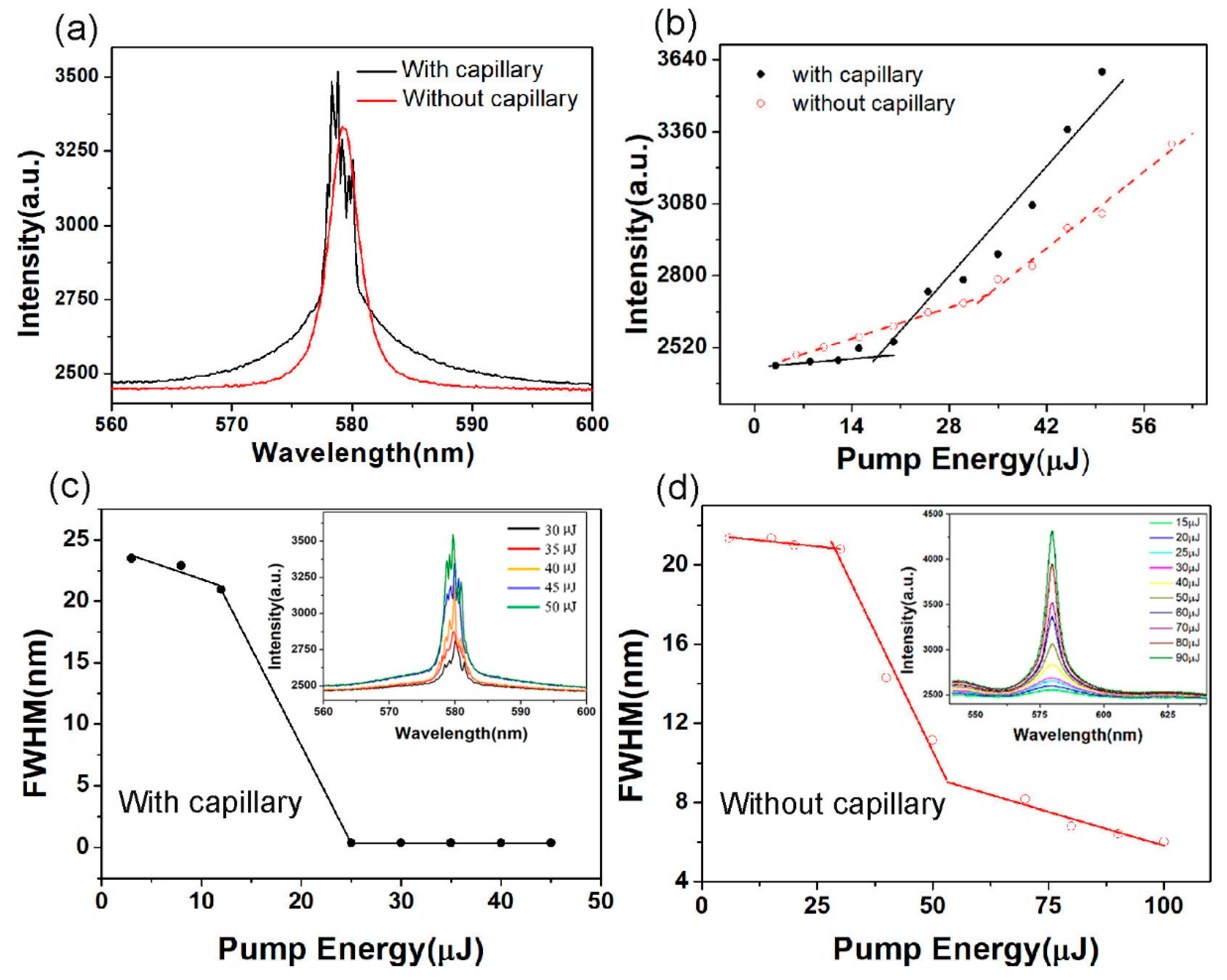
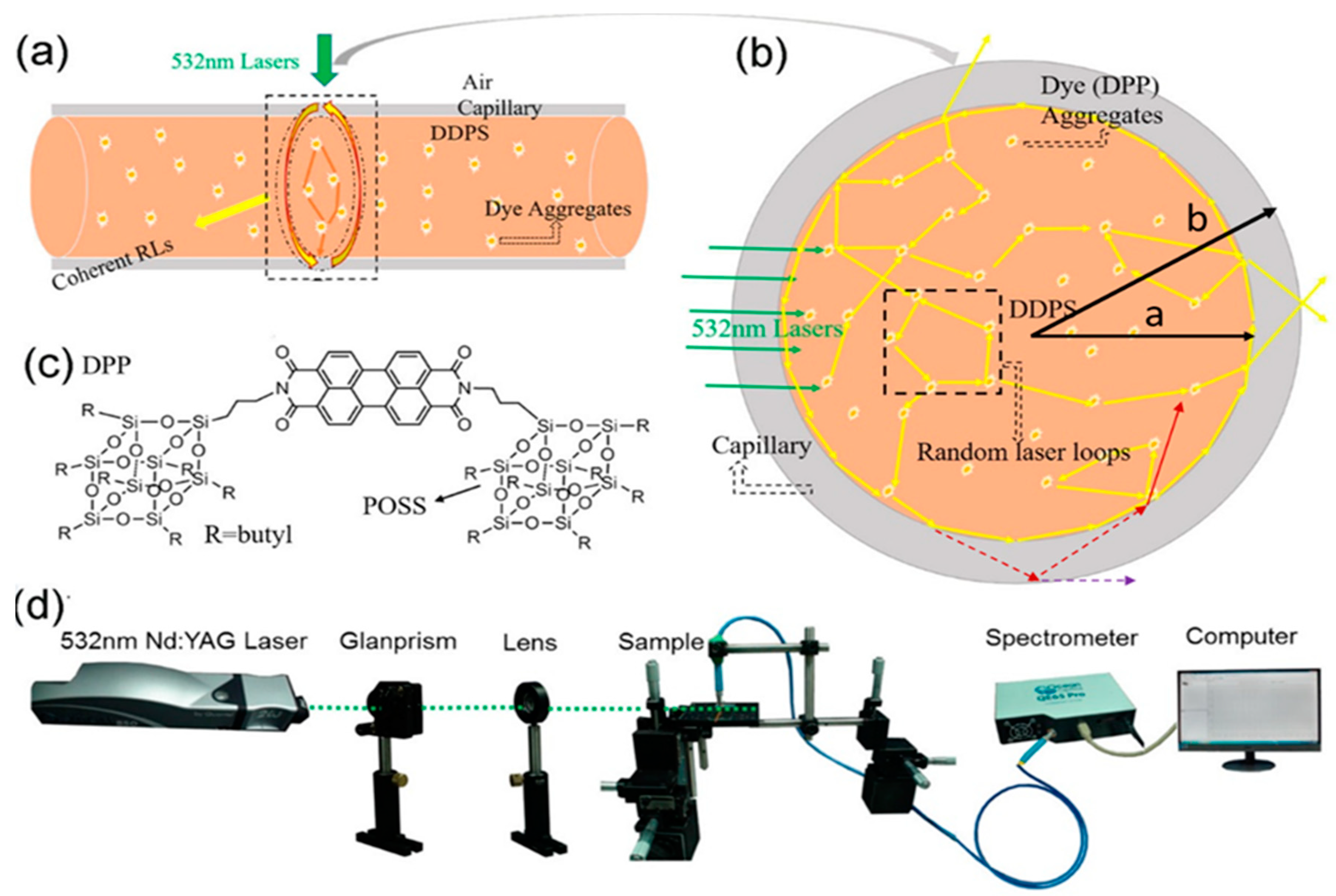
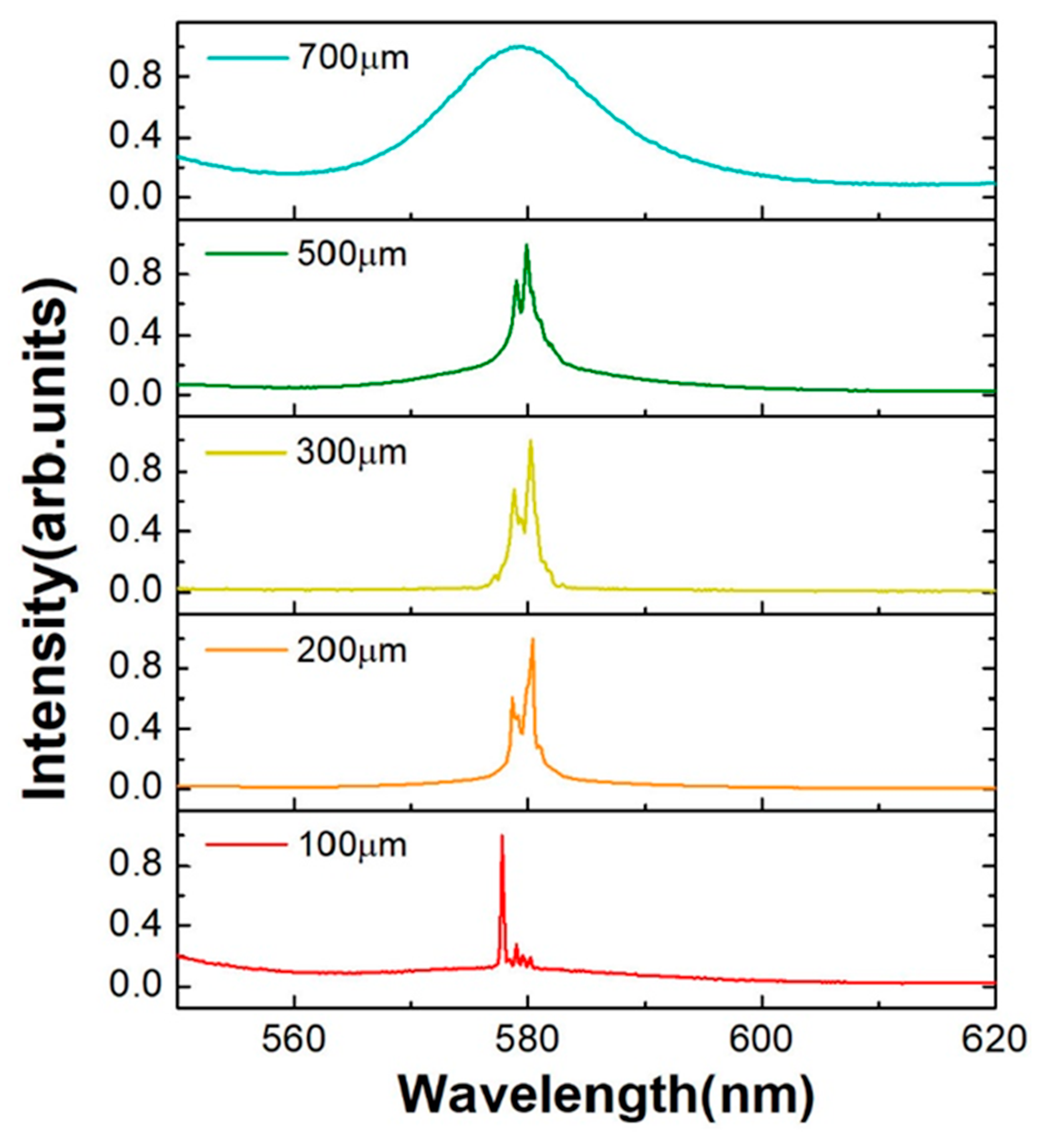
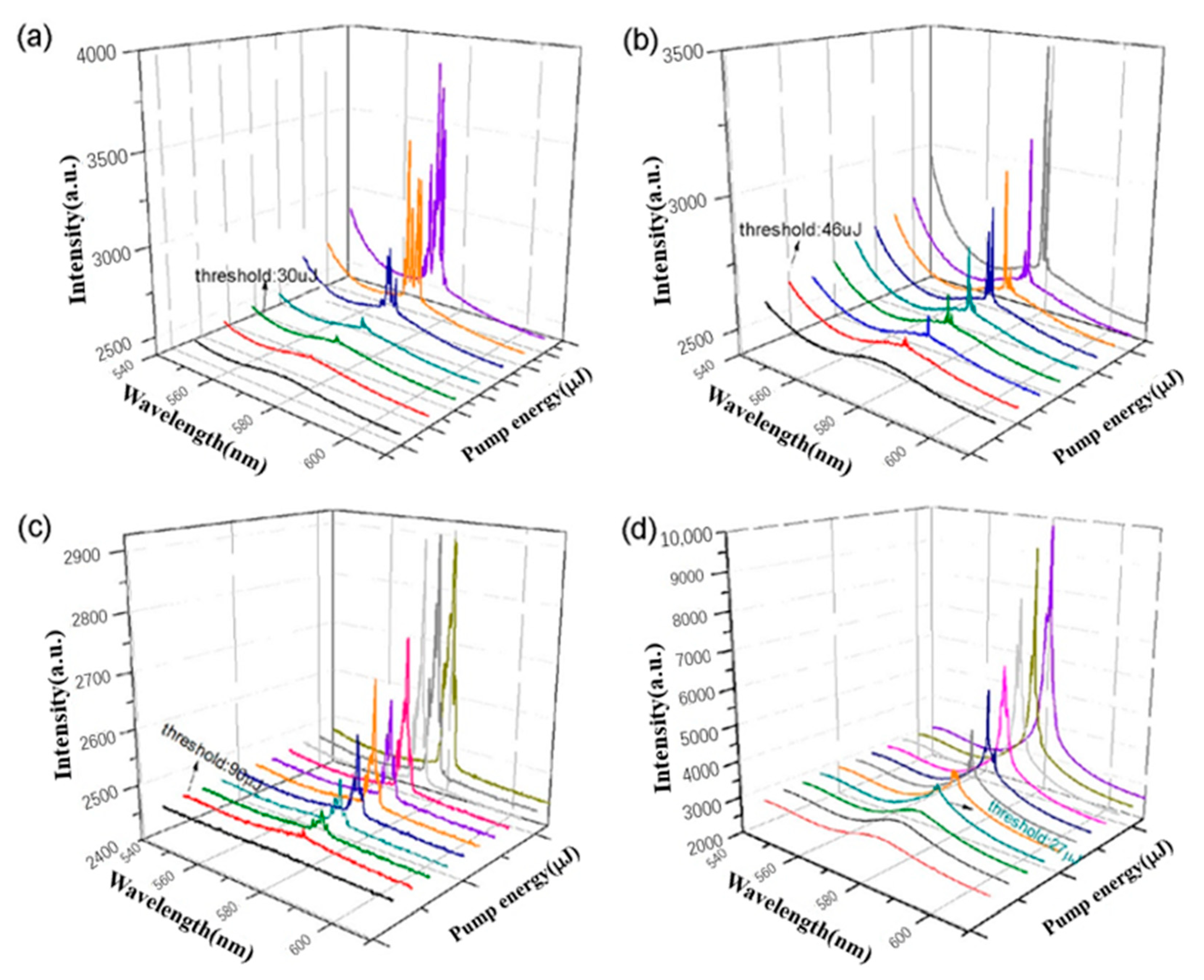

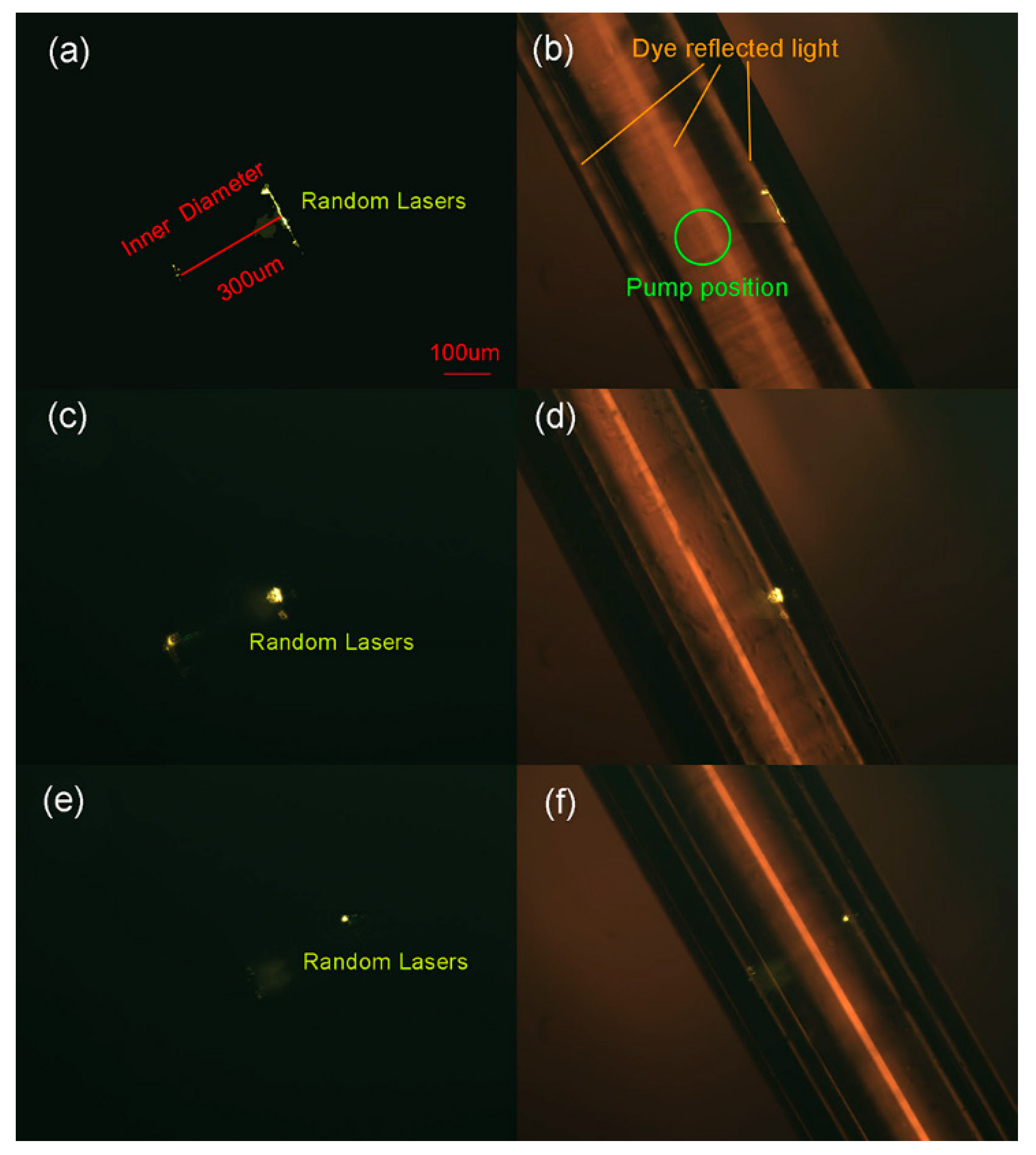
Publisher’s Note: MDPI stays neutral with regard to jurisdictional claims in published maps and institutional affiliations. |
© 2020 by the authors. Licensee MDPI, Basel, Switzerland. This article is an open access article distributed under the terms and conditions of the Creative Commons Attribution (CC BY) license (http://creativecommons.org/licenses/by/4.0/).
Share and Cite
Nie, K.; Wang, Y.; Zhang, Z.; Zou, G.; Xu, X.; Hu, Z.; Zhang, Q. Whispering-Gallery-Mode for Coherent Random Lasing in a Dye-Doped Polystyrene Encapsulated Silica-Glass Capillary. Processes 2020, 8, 1578. https://doi.org/10.3390/pr8121578
Nie K, Wang Y, Zhang Z, Zou G, Xu X, Hu Z, Zhang Q. Whispering-Gallery-Mode for Coherent Random Lasing in a Dye-Doped Polystyrene Encapsulated Silica-Glass Capillary. Processes. 2020; 8(12):1578. https://doi.org/10.3390/pr8121578
Chicago/Turabian StyleNie, Kai, Yueqi Wang, Zhenzhen Zhang, Gang Zou, Xiaolong Xu, Zhijia Hu, and Qijin Zhang. 2020. "Whispering-Gallery-Mode for Coherent Random Lasing in a Dye-Doped Polystyrene Encapsulated Silica-Glass Capillary" Processes 8, no. 12: 1578. https://doi.org/10.3390/pr8121578
APA StyleNie, K., Wang, Y., Zhang, Z., Zou, G., Xu, X., Hu, Z., & Zhang, Q. (2020). Whispering-Gallery-Mode for Coherent Random Lasing in a Dye-Doped Polystyrene Encapsulated Silica-Glass Capillary. Processes, 8(12), 1578. https://doi.org/10.3390/pr8121578





